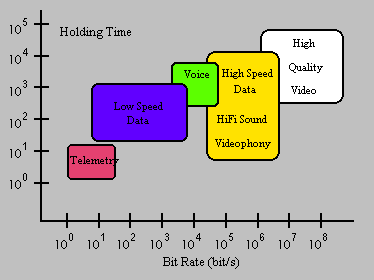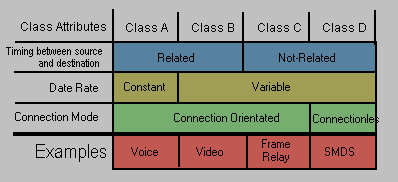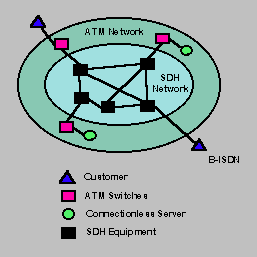Asynchronous Transfer Mode (ATM)
© Mercury Communications Ltd - November 1992
 The demise of ATM
-February 2007
The demise of ATM
-February 2007
 Network updates - 2007
Network updates - 2007
 TechnologyInside
blog
TechnologyInside
blog
Prievious issues of Technology Watch have looked at two types of broadband service: frame relay and SMDS. Both are early progenitors of full public broadband ISDN (B-ISDN). B-ISDN is the holy grail of the telecommunications industry which will enable full integration of data, image, video and voice services. It is effectively a combination of asynchronous transfer mode (ATM) cell switching technology and synchronous digital hierarchy(SDH) transmission techniques.
History of ATM
Early packet switched networks suffered from high data error rates because of the copper based transmission medium. Acceptable levels of bit error were achieved by error detection and correction at every node in a network, as exemplified by the X.25 protocol. In those early days, error correction was done using software, making high data rates impossible. Although this can now be replaced by faster microchip hardware to run X.25 protocol up to 2Mbit/s, the need for even higher rates has driven the telecommunications industry to look at other solutions.
A change of strategy has been brought about by the widespread use of fibre optic cable by public carriers. This transmission medium is much less prone to interference from outside noise sources than copper based links. This has enabled the development of data services with error correction only in the receiving equipment for detecting corrupted packets. This approach is taken by all the services under the generic title of fast packet, such as frame relay, SMDS and cell relay.
Another consideration is that of link delays and latency. Some services require the bit stream to arrive after a short, predictable, delay. Typical examples of these real time, isochronous,services are voice, video, and video-conferencing. The variable length packets or frames of typical LAN and frame relay services can lead to unpredictable delays making them unsuitable for use on real time applications. To correct this limitation, cell relay services use a fixed-length frame called a cell. The use of cells, combined with minimum error management on nodes, result in services called cell relay. Asynchronous transfer mode (ATM) is a cell relay based service as shown in table 1.
Feature X.25 Frame ATM
Relay
Variable Length Frame Yes Yes No
Error Detection Yes Yes No
Error Correction Yes No No
Table 1
The CCITT has already specified in 1988 that one of the B-ISDN standards for the transmission domain will be SDH. This is capable of supporting virtually error-free data transmission at Gbit/s rates over unrepeatered cables of up to about 70km in length. At that time, is was also agreed that the transfer mode or protocol for B-ISDN would be ATM. In other words, ATM is the first global packet standard to support voice, data, image and video.
Performance Requirements
In a future broadband network a large number of disparate services will have to be transferred, as shown in Figure 1. These cover a vast range of bit-rates with telemetry at the low end through to high quality video at the top end. Therefore, the transfer mode selected for B-ISDN must be capable of supporting the requirements of all these services, and others yet unrealised. This consideration led CCITT to choose a transfer mode that will not suffer from the disadvantages of earlier transfer modes such as service dependence, not being future safe, and not being adaptable to bursty data sources.

Figure 1 - Broadband Range of Services
On the contrary, the ideal transfer mode should be:
- Flexible and future safe
Advances in compression algorithms and VLSI techniques may reduce the bandwidth requirements of existing services. New services, including multimedia, are emerging. All these changes can be supported without modification of the ATM infrastructure.
- Efficient use of available resources
All available resources in a network can be used by all services. No resource specialisation exists in an ATM network. Also, similar to X.25, frame relay and SMDS, it allows multiple logical connections to be multiplexed over a single physical interface. This will lead to optimal sharing of resources.
- One universal network
Since only one network needs to be designed, controlled, manufactured and maintained, the overall costs of a system are lower due to economies of scale. ATM will bring similar benefits in packet switching to those of as SDH in transmission.
What is ATM?
ATM is a specific implementation of cell relay technology and can be classified by the following cluster of characteristics:
- ATM has no error management
ATM is intended for use with high-integrity fibre optic transmission, so error protection located at every node can be omitted. ATM, in common with frame relay and SMDS, relies on customer premises equipment (CPE) having sufficient in-built intelligence to handle error management.
Loss of packets due to queue overflow or congestion is a typical problem with ATM since no flow control is provided on nodes and queues could momentarily be overwhelmed by different sources. It is hoped that this packet loss will be limited to small values thanks to the connection oriented nature of ATM.
- ATM operates in a connection-oriented mode
In common with frame relay and unlike SMDS which is a connection less service, ATM is connection-oriented. Before information can be transferred from source to destination, a connection set-up phase must be undertaken. This allows time for the network management software to set up a path through the network and to ensure that sufficient resource and bandwidth are available to support the transfer. When the transfer has been completed, these resources are released. This connection-oriented mode of operation allows the network to guarantee minimal packet loss and thus high integrity.
- Reduced header functionality
To guarantee fast processing within the network, the ATM header has a very limited role. Its main function is to identify of the virtual path through the network. A cyclic redundancy code (CRC) in the header enables the detection of errors which would lead to the mis-addressing of the cell. If a single bit error is detected, it is corrected. If a multiple bit error is detected, the cell is discarded and it is up to the destination CPE to request a resend from the source. As this limited error control is executed in hardware, it can operate at Gbit/s rates and has little impact on data throughput.
- The cell is kept small
The cell is a packet having a fixed, predetermined, length with a header that includes routing information, and an user information field. The fixed format of these two fields allows processing to be achieved with a simple hardware circuit, enabling faster processing speeds than could be achieved with software.
A small cell length guarantees a small delay and delay jitter as required by real time services. An ATM cell, as defined in 1990 by CCITT, consists of a 48-octet information field and a 5-byte header as shown in Figure 2.

Figure 2 - The 53-Byte ATM Cell
The specified length of the information field, given that the header is to be kept as short as possible, is a compromise between transmission efficiency and delay. There were several options to select from:
- A short cell length of 32 bytes or less, so that delays would be small and allowing voice connections to be supported without echo cancellation .
- A longer cell of 64 bytes or more. When a long frame of data, say a 1500 byte LAN frame, is partitioned into cells, efficiency is lost due to the addition of multiple headers. Therefore, from an efficiency point of view, a long cell is preferable. However, for cells longer than 64 bytes, either echo cancellation would be needed for most voice connections, or cells dedicated to voice connections could be only partially filled. However, this approach reduces efficiency tremendously.
- An intermediate cell length of between 48 and 64 bytes. In this case, echo cancellation can be avoided in most cases where the transmission distances are not too large.
Before final agreement within the CCITT, Europe preferred 32-bytes because of the need for echo cancellors for voice, whereas the US and Japan backed 64-bytes for transmission efficiency. The ultimate compromise of 48-bytes was reached in June 1989 in Geneva!
Cells from different users are multiplexed asynchronously. The various streams of cells, containing different types of data from different users, are queued before being interleaved over a transmission medium. The bit-rate of the aggregate cell stream is then adapted to the transmission rate by inserting idle or null cells. These are then discarded when they reach the next node so that a continuous flow of cells is transported.
As with frame relay, the header field contains the connection-oriented path through the network. It also contains a priority flag set by users to determine which cells can be discarded in case of congestion. However, this feature has yet to be fully defined by CCITT. Another feature in the ATM header is payload type . This helps CPE to distinguish between cells that carry user information and those that contain service information.
ATM Class of Service
Like SDH, ATM has been given an unprecedented amount of international attention by the standards bodies. As it is the first packet transmission standard designed to support voice, data, image and video, considerable effort has gone into characterising the types or classes of user service ATM is promising to support. These classes are called A, B, C and D and are profiled in Table 2.

Table 2 - The Four Classes of ATM Service
Timing between source and destination means that the time delay or latency between source and destination is important. Voice and video services need short and predictable delays if echo cancellation is to be avoided. File transfer services, such as needed for LAN-to-LAN connections, can suffer long delays without too much trouble. Data rate is concerned with whether the service is for constant data rate (voice) or bursty data transfers, such as computer file transfers. Connection oriented services are point-to-point data transfers over a known path, while connectionless services allow a packet to traverse a network via any available path. All services carried over ATM can be categorised by a combination of these issues.
In Class A, a time relationship exists between source and destination: delays must be small and predictable. The data-rate is constant and is connection oriented. Such a service is voice, encoded at 64kbit/s as in Narrow-ISDN.
A Class B service is similar to Class A in that data needs to get through the network quickly and predictably. The one difference is that it has a variable bit-rate. A good example of this is compressed video.
A Class C service has no demands in terms of source to destination timing Data rates are variable and it is connection oriented. This is exemplified by frame relay services.
A Class D service is similar to a Class C service except that it offers connectionless facilities. An example of such a service is SMDS.
Fundamental Differences
B-ISDN differs from narrow-ISDN (N-ISDN) in three key areas:
- N-ISDN makes use of the infrastructure of the telephony network as it exists today, using symmetrical copper pairs. B-ISDN will wholly rely on fibre-optic cable.
- N-ISDN is mainly a circuit switch based network and performs packet switching only on the D channel which is used for signalling. B-ISDN uses only cell (packet) switching.
- N-ISDN channel bit-rates are pre specified. For example, 16kbit/s on the D signalling channel and 64kbit/s on the B channels. In contrast, B-ISDN uses only virtual, connection oriented channels without any pre specified rate. The only limitation of the virtual channels is the physical limitation on the user-to-network transmission medium. These are initially set to either 155 or 622Mbit/s, the STM-1 and STM-4 rates. Figure 3 shows B-ISDN network using SDH in the backbone network with connections made via ATM switches.
The Evolution to B-ISDN
It is commonly agreed that data, rather than voice, will play the major role in introducing B-ISDN throughout the world. Although the justification for SDH deployment in 1992 is its ability to provide an upgrade path from 565Mbit/s to 2.4Gbits/s transmission rate on PTO network backbones it is actually the enabling technology for broadband service provision. Over the next 5-years, SDH networks will gradually work their way out from backbone application towards the customer interface, creating the means to support some of the more avant gard broadband applications in discussion today.

Figure 3 - A B-ISDN Network
On the other hand, ATM switching will first be used in private LAN networks where there is an immediate need to integrate services, provide broadband links and move away from shared technologies such as Ethernet, token ring and FDDI. Hub architecture, ATM switched, LAN networks will start to be deployed as early as 1993. In the late 1990s ATM and SDH will grow together to form a uniform broadband environment between customers and PTOs, albeit on an island basis to start.
N-ISDN has suffered, and is still suffering, from vendor-proprietary implementations that are incompatible in many areas. Learning lessons from this mistake, early ATM work has centred on the creation of standards that are both comprehensive and usable.
Although much still needs to be done, the universal nature of SDH and ATM promises the wide scale compatibility so much in demand by customers, LAN manufacturers, and service providers alike.
